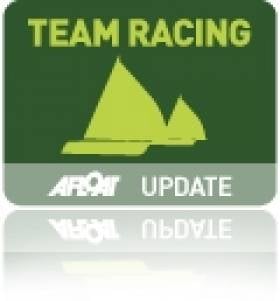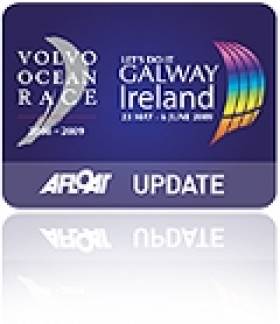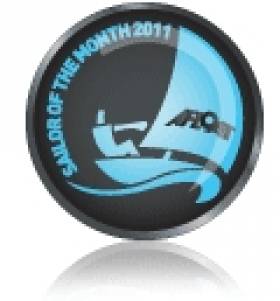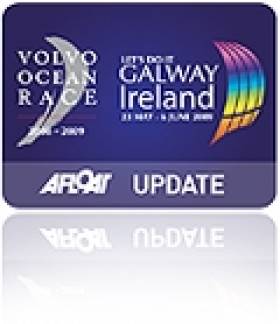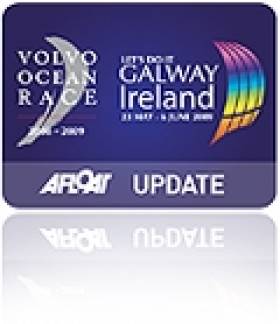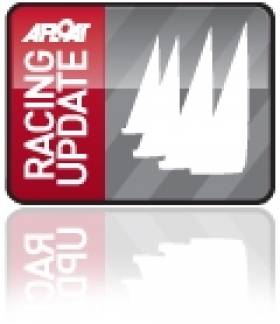Displaying items by tag: race
West Kirby Teams Top ISAF Worlds in Schull
Saturday's racing in the ISAF World Team Racing Championships in Schull Harbour began in light southwesterly winds which developed into a fresh northwesterly by late morning. First action was the semi-final stages of the World Youth Championship.
Here, the host club Schull Community College, representing Ireland, took on Sevenoaks (GBRY2) while the in form Spanish team from Barcelona took on the top ranked British team West Kirby Youth (GBRY1),each in a five race sail off for a place in the World Final. Schull opened with two winning combinations but Sevenoaks hit back ,winning the third with a 1,3,4 combination. However, Schull C.C. took the fourth race to clinch a place in the final.
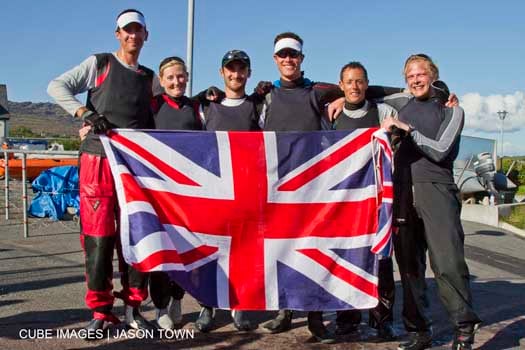
In the second semi the Spanish opened with a flourish and had two wins under their belt before West Kirby Youth seemed to realise they were in a World semi-final and looking defeat in the face. Their backlash came hard and fast. They took the next two
races to level the match and in a dramatic fifth race decider, in which the Spanish team fought to the finish, they secured their final place.
There was huge local anticipation and excitement entering the final with the host club facing the possibility of a World Youth title. However ,they had a shaky start losing the first of the five races.This brought about a loss of composure and with a few penalty umpiring calls going against them, and deservedly so, they forfeited the second race also to a humbling 1,2,3, combination from the British team. A lesser team might have caved in at this stage, but they rallied and hit back, winning the third and fourth races.The final deciding race was contested with passion ,commitment and no little skill, with the home team looking like they would just steal the march with a winning combination approaching the finish, but a finish line infringement cost them the race and the title. West Kirby Youth( GBR3) are the World Youth Team Racing Champions 2011, a tribute to their skill, consistency and discipline throughout this World Championships.
The third place sail off between the Spanish team and Sevenoaks (GBRY2) resulted in a win for the Spanish who, together with the first and second placed youth teams,joined the five Open qualifiers who made the cut, in the Open quarter finals.
This was sailed as a round robin, with the four top ranked teams from the USA and Great Britain making it to the semi- finals, namely, NCYC Team Extreme (USA1), Woonsocket Rockets (USA2), West Kirby Hawks( GBR1) and Wessex Exempt (GBR2). The placings meant that both USA and British semi – finalists were pitted against each other in the penultimate round ensuring a Britain v USA final.
At this stage form and consistency came to the fore with Team Extreme and West Kirby Hawks securing their final berths with three straight wins over their fellow countrymen .
West Kirby Hawks attacked early on and took the first race of the final with a convincing 1,2,3 win. Team Extreme hit back taking the second 1,2,5. The third race proved crucial with Hawks' master tactician Andy Cornah, king of the Championship, working himself and Dom Johnson into 1,2 positions to snatch the win. This proved the race that smashed the American challenge as Team Extreme's Zach Brown was over at the start in the fourth and The Hawks stole in at 1,2,3 , a lead they didn't relinquish. At three races to one the Championship was over and West Kirby Hawks, Great Britain's top ranked team racers ,are worthy ISAF World Team Racing
Champions 2011 and have avenged their defeat by USA's Team Extreme in the British Open Team Racing Wilson Trophy Final back in May of this year. The bronze medallists are Woonsocket Rockets (USA2) who defeated Wessex Exempt(GBR2) with three straight wins in the sail off for third place.
RESULTS
OPEN WORLD CHAMPIONSHIP :
1. West Kirby Hawks ( GBR1)
Helms: Andy Cornah, Ben Field, Dom Johnson.
Crews: Hamish Walker , Tom Foster, Deborah Steele.
2. NYYC Team Extreme (USA1)
Helms: Zach Brown, Peter Levesque, Stuart Mcnay
Crews: Emmet Smith, Marla Menninger, Michael Hession.
3. Woonsocket Rockets (USA2)
Helms: Joel Hanneman, Brian Kamilar, Justin Law.
Crews: Alexa Schuler, Lyndsey Gibbons- Neff, Adrienne Patterson.
YOUTH WORLD CHAMPIONSHIP:
1. West Kirby Youth ( GBRY1)
Helms: Cameron Douglas, Ben Robinson,Sophie Shepherd.
Crews: Sarah Lombard, Charlie Fitzgerald, FreddyWilliams.
2. Schull Community College (IRLY3)
Helms: Conner Miller, Oisin O' Driscoll, Jay Stacey
Crews: Ellen O' Regan, Katie Moynihan, Kasper Snashall.
3. Spain (ESPY1)
Helms; Carlos Robles, Adriana Rodes, Jordi Xammer.
Crews: Florian Trittel, Lucia Brugman, Alex Claville.
Rosanna Davison Goes Back to Her Roots Sailing with Team Sanya
Skipper and past race winner Mike Sanderson and his crew - including Galway's Frankie Leonard - will receive a special send-off from Rosanna who won her Miss World title in the Chinese city of Sanya in 2003.
Team Sanya is the Chinese entry in the 2011-12 Volvo Ocean Race, a 40,000-mile round the world race that will finish in Galway on the 3rd July 2012. A special relationship developed between Ireland and China during the last race through the Green Dragon entry, say backers Discover Ireland, the tourism body.
Rosanna will board the yacht at 11.00am at the Royal Irish Yacht Club and will sail with the team into Dublin Port. The Eastlink bridge will lift at 1.00pm, and Team Sanya will dock beside the Cill Airne at 2.00pm. Rosanna will be on the Cill Airne from 5.30-7.00
As part of the team's promotion and it's Irish link through the Discover Ireland.com brand, the race boat and crew will call into Dun Laoghaire on Sunday, 4th September, at 5pm as previously reported on Afloat.ie.
They will overnight in Dublin and sail up the Liffey on Monday at 1pm and dock beside the MV Cill Airne on North Wall Quay, Dublin 1. A reception will be held on the MV Cill Airne from 5-7pm.
At 7pm the Team will head back out into the open sea as they start their journey to Alicante for the race start on the 5th November.
The Volvo Ocean Race is regarded as sailing's premier global race and one of the most demanding team sports in the world. The 2011-2012 Volvo Ocean Race route is: departing on 5th November from Alicante to Cape Town (South Africa) Abu Dhabi (UAE) Sanya (China) Auckland (New Zealand) Itajai (Brazil) Miami (USA) Lisbon (Portugal) Lorient (Framce) and finally Galway on the 3rd July 2012.
Mike Sanderson, skipper and CEO of Team Sanya commented on the forthcoming trip: "Our relationship with Ireland is really important to us. Frankie Leonard from Galway is our media crew member and he is going to be paramount in telling our story as we race around the world, building the profile of Ireland as the stunning tourist destination that it is. For many of our team, it is our first time visiting Ireland so we were really happy to include a pitstop in Dublin during one of our training trips."
Frankie Leonard, Team Sanya race team and the Irish Media Crew Member, added: "As the only Irishman on board I'm very proud to be part of this exciting event with Team Sanya and really looking forward to sailing into Dublin next week. My home town is Galway and finishing there in July 2012 is going to be a very special moment but this stop-over is a perfect way to help build a strong following and fan base in Ireland to develop Ireland's profile as we travel to nine other ports around the world."
Kieran Cotter and Jerry Smith Named Sailors of the Month for August
When Rambler's canting keel snapped off on the evening of Monday August 15th shortly after this mega-machine had rounded the Rock, she was powering at full speed towards the turning buoy, crashing into the lumpy seas which often arise where the steep land juts into the open ocean.

Kieran Cotter and the crew of the Baltimore lifeboat at the capize site. Photo: Thierry Martinez
The catastrophe was total and very sudden. The giant racer completely inverted every bit as quickly as the smallest of racing dinghies. The changeover, from being a highly tuned performer on track for success, into the inverted hell of exploding water, strangling ropes and jagged breaking gear, was at the least totally disorienting, and could have caused panic in less seasoned sailors.
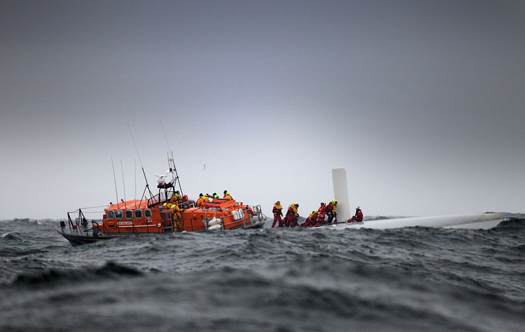
The Lifeboat rescue from the upturned hull. Photo: Team Phaedo
Despite the difficulty of clambering onto the ultra-smooth underside of the huge hull, fifteen of the crew managed to get themselves up to the minimal handhold of the dagger board. But five of those who had been below – some of them off watch asleep – had drifted away from the boat after the monumental struggle of escaping from a small world turned upside down.
The five in the water roped themselves together, but things had taken an ominous turn, as the mist in which the big boat had rounded the Fastnet had now thickened into fog. For a crucial period, visibility was virtually nonexistent as other boat raced past nearby at high speed. And although some emergency radio beacons had automatically activated, the picture was confused with night drawing on.

Drifting crew are rescued. Photo: Team Phaedo
Time was of the essence – even in summer these waters can quickly induce hypothermia. Several agencies were now involved in the rescue, and skilled use of technology narrowed the search area, though in the sea conditions the stricken boat and crew were frequently invisible.
It was the Baltimore lifeboat with Kieran Cotter in command which was first on the scene. Taking off the crew was a challenge, but all fifteen on the upturned Rambler were safely rescued, though an impact between lifeboat and white hull resulted in a streak of lifeboat blue on the yacht which was to be immortalised as "Kieran's kiss".
But that was later, not until after a needle-in-a-haystack search found the other five adrift together in the water, with one already on the edge of coma. They were found by the lifeboat deputy mechanic Jerry Smith, on patrol with a Fastnet Race film crew in his dive boat Wave Chieftain. It was a miracle.
Next morning safely in Baltimore, the weather was already well improved. The previous night's conditions seemed like a nightmare. In calm summery conditions two days later, the Rambler hull was righted off Barley Cove and towed to Baltimore. She'll be restored to full racing trim by Cookson's in New Zealand, presumably with modifications to the design and specification for the canting keel. But that's another day's work. Today, we celebrate the achievement of Kieran Cotter and Jerry Smith, whose seamanship provided the successful focus for a network of rapid work by skilled technologists ashore.
Coverage of the rescue appears in Afloat's Rolex Fastnet Race page
Round Ireland Yacht Race 2012 Starts from Wicklow on Sunday, June 24th
Volvo 70 Team Sanya Heading for Dun Laoghaire
The Volvo Ocean Race Chinese entry, Team Sanya, backed by Discover Ireland, is coming to Dublin Bay this Sunday afternoon. She will berth alongside the Royal Irish Yacht Club according to the promoters. At 4pm the Mike Sanderson skippered boat will round a turning mark off Dun Laoghaire harbour before berthing in the port. Team Sanya is a refurbished version of the Telefónica Blue boat from the 2009 race.
Piracy Threat Forces Volvo Ocean Race Route Change
The escalating piracy problem in the Indian Ocean has forced organisers of the Volvo Ocean Race 2011-12 to redraw the routes for the second and third legs.
The boats were due to have sailed through an East African corridor in the Indian Ocean on the second leg from Cape Town to Abu Dhabi and again in the third leg from Abu Dhabi to Sanya in China but after taking advice from marine safety experts and the sport's governing body, the International Sailing Federation (ISAF), the routes have been changed.
The boats will now race from Cape Town to an undisclosed 'safe haven' port, be transported closer to Abu Dhabi, and then complete the leg from there. The process will be reversed for the third leg before the race continues on to Sanya.
"This has been an incredibly difficult decision," said Volvo Ocean Race Chief Executive Knut Frostad. "We have consulted leading naval and commercial intelligence experts and their advice could not have been clearer: 'Do not risk it.'
"The solution we have found means our boats will still be racing into Abu Dhabi and competing in the in-port race there.
"Abu Dhabi is a very important part of our plans, a real highlight being the race's first-ever stopover in the Middle East, and we will now have a really exciting sprint finish to the emirate over the New Year period as well."
Abu Dhabi will host the race from December 30 to January 14 with a purpose-built race village at its Corniche waterfront site and a headline New Year's Eve concert amongst various festivities set to provide a spectacular welcome to more than 100,000 visitors.
"The measures taken by the Volvo Ocean Race are very much in line with the advice that the International Sailing Federation has been giving for some time." said ISAF Secretary General Jerome Pels. "The ISAF strongly urges all yacht skippers intent on sailing anywhere in the area to seek an alternative, which the Volvo Ocean Race is now providing."
Three Volvo 70s Start the Fastnet Race (Pics here)
One of the most impressive sailing sights from the weekend was on the Solent yesterday when three Volvo Ocean Race 2011-12 entries Groupama Sailing Team, Abu Dhabi Ocean Racing and current leader Team Sanya started the Rolex Fastnet Race, the first full blooded test of the boats in the build up to October's start. Ireland has a sponsorship tie in with the Sanya entry and it also has an Irish media man onboard.
Sanderson Unveils 'Discoverireland' on Team Sanya
Team Sanya are working in close partnership with 'Lets Do It Global', organisers of the Volvo Ocean Race Finish in Galway, under the 'discoverireland. com' brand.
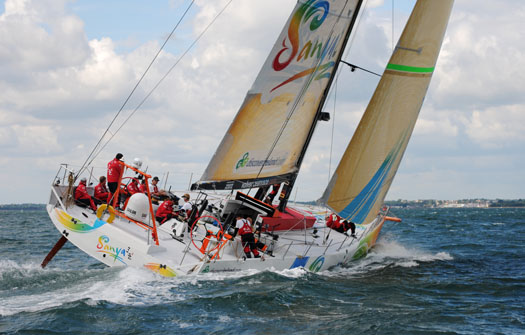
Team Sanya afloat in Irish colours. Photo: Tim Stonton
This is the second time China and Ireland have partnered with China to enter a boat into the Volvo Ocean Race. The first was with the Green Dragon Team in 2008-2009. Sanya, is situated in the southern most city in China and is a popular tourist destination. It is also where Rosanna Davidson won her Miss World title in 2003.
The chairman of Let's Do It Global Enda O'Coineen said ''this partnership with China and Ireland for Team Sanya is a dynamic collaboration of all Irish interests. Led by tourism, it will leverage the extraordinary opportunity the Volvo Ocean Race coming to Ireland presents. Having such a professional team and a skipper with the calibre of Mike Sanderson, twice winner of the Volvo Ocean Race and a Media Crew Member, Galway man Frankie Leonard on board we are assured of a very exciting race, culminating in the final in Galway on the 3rd July 2012. As final destination, Galway will host the largest festival in the country.
This is a major opportunity for the tourism sector and all Irish based businesses. We have developed "Global Village 2012" with four pillars, Food, Innovation, Green and Marine, as a platform to showcase to a global audience all that is good about doing business in Ireland."
The Volvo Ocean Rcae is regarded as sailing's premier global race and one of the most demanding team sports in the world. The race will begin on 29 October in Alicante, Spain and will finish in Galway early July 2012. is the stopover ports include Cape Town, Abu Dhabi, Auckland, Itajai in Brazil, Miami, Lisbon, and Lorient.
Royal Navy to Start Clipper Race from Southampton
With one week to go until the gun fires to signal the start of the Clipper 11-12 Round the World Yacht Race, the first global event to set off from the Solent since 2004, organisers are thrilled to welcome the Royal Navy's helicopter carrier, HMS Illustrious, which will attend the weekend's festivities in Southampton, culminating in the race start on Sunday 31 July.
Ireland is represented by the City of Derry entry. The race will stop there in its course around the world.
At 40,000 miles Clipper 11-12 is the world's longest yacht race and almost 500 people from all walks of life and representing more than 40 nations will take part, putting their everyday lives on hold to take on the challenge of a lifetime. More than 40 per cent of them had no sailing experience before beginning their rigorous pre-race training.
Commanding Officer of HMS Illustrious, Captain Jerry Kydd, said, "HMS Illustrious is delighted to be in Southampton to support the start of the Clipper Round the World Yacht Race. The Clipper Race stands for much of what the Royal Navy and Royal Marines hold dear: personal determination and fortitude, in dangerous and demanding conditions, where teamwork, resilience and a winning spirit overcome any challenge the crews may face on their adventure. On behalf of the officers and crew of HMS Illustrious, I wish all yachts and their crews the very best of luck for a safe and fast circumnavigation and a cracking race!"
Founder and Chairman of the Clipper Race, Sir Robin Knox-Johnston, the first man to sail solo and non-stop around the world, said, "The Clipper Race has always had a very strong relationship with the Royal Navy and I am very pleased to welcome HMS Illustrious for the start of Clipper 11-12. She is part of the large maritime community of the south coast and I am very keen that as many members of that community as possible are able to enjoy this event which promises to be a quite spectacular sight."
Many boat owners and sailing enthusiasts will be joining the flotilla of spectator boats to watch the parade of sail in Southampton Water from 2.30pm – where the ten ocean racing yachts will sail in formation ahead of HMS Illustrious – before the race begins at 4.30pm from the historic Royal Yacht Squadron line.
HMS Illustrious will arrive in Southampton on Saturday 30 July and will be berthed at the QE2 Terminal. A raft of free, family friendly entertainment is taking place over the weekend in Ocean Village where the ten 68-foot yachts contesting Clipper 11-12 will be based. Live music will include sets by Southampton groups, Delays and Parade, as well as Toploader, who will headline on Friday night. As well as the live music on stage other entertainment in the Race Village will feature African dancers, acrobats, drummers and fire eaters plus a spectacular fireworks display on Saturday night.
Tens of thousands of people are expected to visit the race village between Thursday 28 July when the yachts arrive and Sunday 31 July when the teams will say an emotional farewell before setting off on their 12-month circumnavigation. The course will take them to 15 ports on six continents and across the largest and most ferocious expanses of water on the planet. Each of the colourful yachts bears the name of the city, region, country or company it represents.
Southampton City Council and MDL Marinas, owner of Ocean Village Marina where the yachts will be berthed, are working in partnership to host the Clipper 11-12 race start, the eighth edition of the event established by Sir Robin to give people from all walks of life the opportunity to take part in the life-changing experience of ocean racing.
As the official host port for the race start Southampton can expect a significant economic return from the tens of thousands of visitors expected to visit the city over the four days the fleet will be in Southampton, delivering millions of pounds worth of revenue for local businesses.
Irish Yacht Wins Three Peaks Yacht Race
The victory was all the remarkable given the Ker 35 was last across the line after a disastrous start. The race began at Barmouth on the mid-Wales coast last Saturday and sea conditions were treacherous with 20 foot waves making it difficult for the race fleet to even leave the harbour.
Danu Techologies, entering the race for the first time, was still being prepared minutes before the start, had to be cut from its moorings and then suffered damage as it motored through the worst of the seas to the start line. Crashing down from a big wave one of the runners aboard was swept across the deck and broke a stanchion, which then punctured the jib, and the navigation computer on which the race route had been planned was destroyed. As the start flare fired the boat was out of position with its mainsail trailing, yet the crew of 3 and their two mountain runners finished the race as winners. They made the 6th fastest passage to Caernarfon, where elite Irish mountain runners, Deon McNeilly and Gary Bailey, made the 24 mile crossing of Mount Snowdon, the highest point in Wales, in the hours of darkness in 5 hours and 10 minutes. After a safe passage of the Menai Strait, and with light winds prevailing, the racing pedigree of a boat designed originally for the IRM Grand Prix rule enabled the team to take the lead. The runners then stayed ahead on the longest land stage, reaching Scafell Pike, England's highest summit, after a mountain bike ride to Ennerdale and a run across Black Sail Pass, which took 8 hours and 6 minutes.
The 32 boats taking part faced strong headwinds, then light airs and periods of calm on the route around the Mulls of Galloway and Kintyre and up through the Inner Hebridean islands to reach Fort William, and the final summit, Ben Nevis. A unique feature of the race is that yachts are rowed through periods of calm and the crew of Andrew Miles and John Prudhoe, took their turn at the oars when required to stay ahead of the challenge from Team Whistler, an Australian team who have formerly won the Tasmanian 3 Peaks Yacht Race and were looking for a unique double win in a Reflex 38. Unable to make up the deficit when they arrived second at Fort William the Australian team switched tactics to win the Tilman Trophy, which requires 4 of the team to reach a mountain summit. Skipper David Rees and crewman Tim Jones put on their walking boats to climb Ben Nevis and claim the prestigious trophy, though they did lose second place overall to Team White Cloud, a HOD 35, skippered by John Donnelly.
The other major trophy of the race, for the Kings of the Mountains, went to endurance runners Martin Beale and Ian Ridgeway, who were racing on team Peaks Addix. They were fastest on all 3 peaks and had a total running time of 13 hours 30 minutes, 2 hours ahead of their nearest challengers.
From the 32 starters there have been 5 retirements and 4 boats are presently still making their way to the finish. At the back of the field is another international team, The Flemish Lowlanders, whose runners were involved in a dramatic rescue of two climbers on Scafell Pike on Tuesday. The Belgian team have until the course closes at 18.00 on Saturday to reach the finish line and complete the race.


























